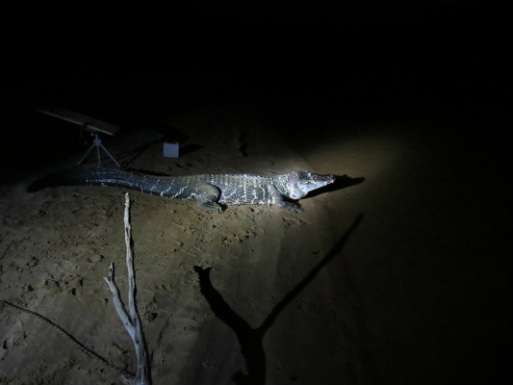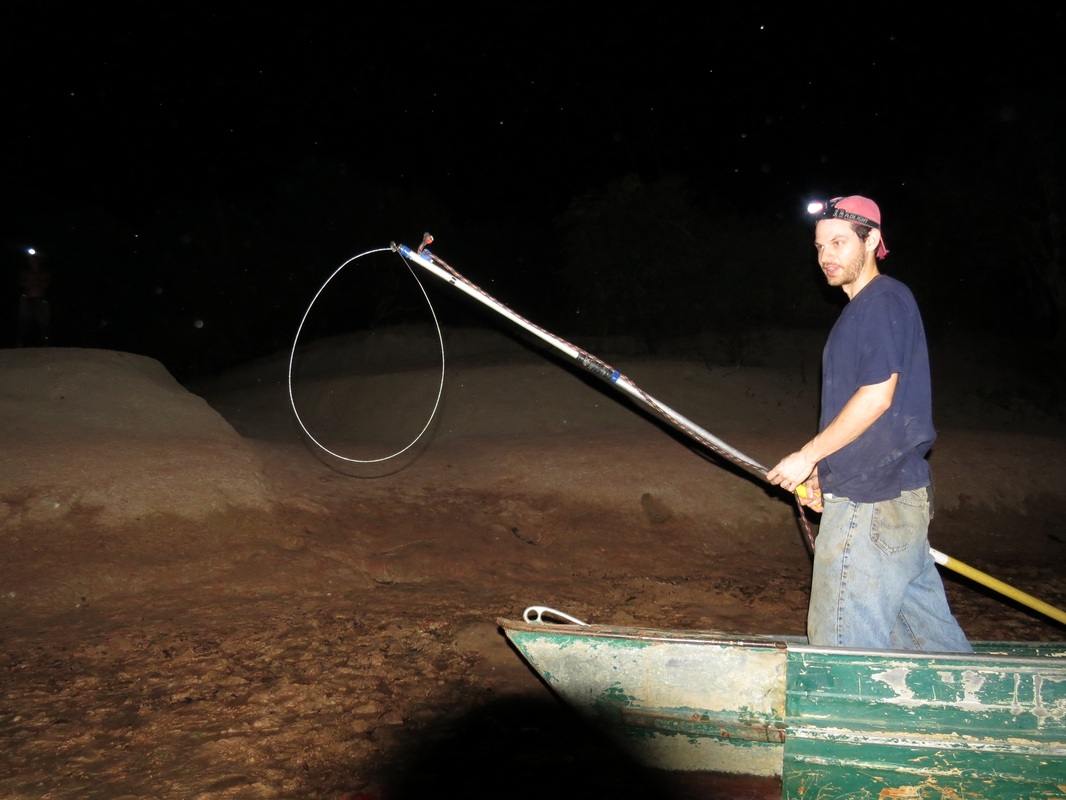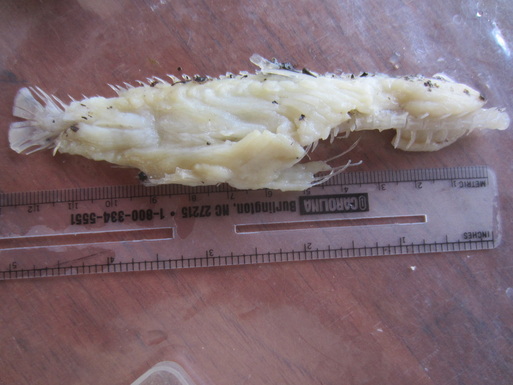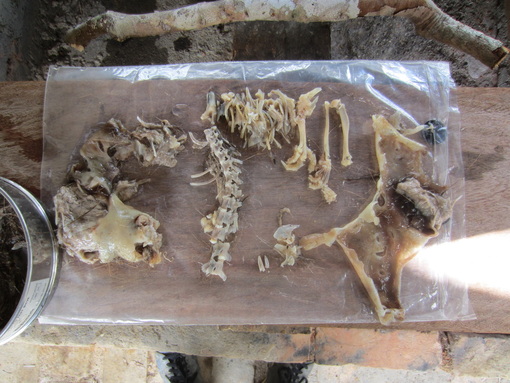|
-- Adam Rosenblatt Post-doc  Photo Credit: Axel Schulz Photo Credit: Axel Schulz Catching caimans is not that complicated. First, you get in a boat at night, head out on the river, and use high-powered spotlights to find the animals. The light from the spotlights bounces off the tapetum lucidum (a layer of tissue within the retina that reflects light back into the eye, increasing the clarity of night vision), making the caiman’s eyes shine bright red from hundreds of meters away. Second, you drive the boat slowly towards the caiman, making as little noise as possible (crocodilians have good hearing). Third, a person at the bow of the boat uses a long pole to slip a metal snare around the neck of the caiman, and then tightens the snare by pulling on the rope it’s attached to or by yanking the pole upwards swiftly. Fourth, you hold on for dear life as the caiman thrashes around in the water, tiring itself out. Crocodilians tire relatively quickly (5 minutes or so) during bursts of intense physical activity because lactic acid, a natural by-product of cellular metabolism, builds up in their muscles and shuts them down. Human muscles also suffer from lactic acid build-up during exercise, but our muscles are able to get rid of it relatively quickly while crocodilians are stuck with it for longer periods of time because of their cold-blooded physiology. Fifth, you use a second snare to close the mouth and secure it, then you tape the mouth shut. Now you’re ready to safely handle the animal. During my time in Guyana my local counterparts and I caught 30 adult caiman this way, and to find out what they were eating we pumped their stomachs. Instead of explaining the whole stomach pumping process, you can watch this short video I made: https://www.youtube.com/watch?v=JCmogf-NQ2Y We ended up finding lots of interesting stuff in their stomachs, like snails, fish, seeds, and small mammals. Fish were by far the most frequently consumed type of prey, which means in the region I was in fishermen and caimans directly compete for food, at least during the dry season. The long-term challenge is to figure out how, despite this overlap, to maintain the quality of life for humans who depend on fish for food while also protecting the caiman population and the important roles caiman play in local food web and ecosystem dynamics. My goal is to go back to Guyana in the coming years to continue and expand upon the caiman research I began in February.
28 Comments
2/21/2023 01:31:31 pm
Some truly wonderful work on behalf of the owner of this internet site , perfectly great articles .
Reply
8/19/2023 10:56:30 am
Thank for the information, please visit
Reply
8/24/2023 01:52:28 pm
Good article, thanks for sharing, please visit
Reply
9/6/2023 11:19:28 pm
Thank you for sharing this fascinating insight into the process of catching caimans and studying their dietary habits. Your dedication to understanding the delicate balance between human and caiman food sources in Guyana is commendable. Best of luck with your future research endeavors in the region!
Reply
9/15/2023 03:44:28 am
Gracias por la buena redacción. De hecho, era una cuenta de diversión. ¡Mira avanzado a lo lejos agregado agradable de ti! Por cierto, ¿cómo podemos comunicarnos?
Reply
4/22/2024 03:30:43 pm
I'm Komal Kaur, an escort that loves to party hard and never says no to a good time with guys who can make me feel like a rock star again.
Reply
6/7/2024 06:04:46 pm
Glad to chat your blog, I seem to be forward to more reliable articles and I think we all wish to thank so many good articles, blog to share with us.
Reply
6/14/2024 04:55:15 am
Thank you for the information , visit Banyuwangi tourism at. <a href="https://amanahtrans.my.id/">Sewa mobil banyuwangi</a>
Reply
شركة مكافحة الحشرات تُعتبر من الشركات الضرورية في مجتمعاتنا اليوم، حيث تقدم خدماتها للتخلص من مشاكل الحشرات التي قد تؤثر سلبًا على صحة الإنسان والبيئة. تعمل هذه الشركات على توفير حلول فعالة لمكافحة الحشرات المنزلية والتجارية، مثل النمل والصراصير والبق والفئران والنمل الأبيض وغيرها. تتضمن خدماتها استخدام مواد آمنة وفعالة للقضاء على الحشرات بشكل دائم، مع الحرص على الحفاظ على صحة الأفراد وسلامة البيئة. بالإضافة إلى ذلك، تقدم الشركات خدمات استشارية للوقاية من الحشرات وتقديم نصائح للحد من انتشارها في المنازل والمباني التجارية. في النهاية، تساهم شركات مكافحة الحشرات في تحسين جودة الحياة والصحة العامة من خلال توفير بيئة خالية من الأضرار الناجمة عن الحشرات.
Reply
Absolutely fantastic article! The insights are not only spot on but also incredibly enlightening. Your expertise shines through and makes a real impact. I can't wait to see more of your outstanding content!
Reply
Leave a Reply. |
Archives
November 2019
Categories
All
|



 RSS Feed
RSS Feed
